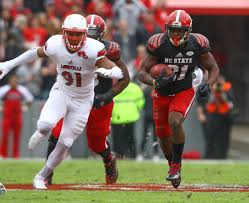
My tour around the running back rookies continues with Ka’Deem Carey. The former Arizona back measured in at 5’ 9” and 207 lbs., but ran a very disappointing 40 time of 4.70 at the Combine. Now that 40 time alone won’t drop his stock  too much, but it is concerning. I reviewed five of his 2013 games against USC, Oregon, Colorado, Washington State, and UCLA to get a better idea of what skill level he will bring to the NFL.
too much, but it is concerning. I reviewed five of his 2013 games against USC, Oregon, Colorado, Washington State, and UCLA to get a better idea of what skill level he will bring to the NFL.
At first blush, Carey reminds me a lot of Stepfan Taylor, the former Stanford running back that got drafted in the 5th round by the Arizona Cardinals. The rookie is a bit smaller, but shares the same running style and overall skill set. I do think that Taylor is the superior short yardage back though. Much like Taylor, Carey needs high volumes to be successful. Also keep in mind Taylor did not make much of an impact his rookie season.
There are some major concerns in his play that may limit him early in his career. He looks a bit lost on pass protection. The back doesn’t plant his feet and seems unaware of where pressure is coming from, that effort and skill will get a quarterback crushed. Carey made a few dives at blitzer’s legs or threw a shoulder at them, just hoping to make contact. Despite that effort, the runner does sell fake handoffs well. If he has any chance to stay on the field on passing downs, he will need to greatly improve his pass blocking. I was impressed with Carey as a run blocker as unlike his pass blocking, he fired out and got in front of a defender driving them back, so maybe there is hope for him. The young runner also has issues with turnovers as he doesn’t sense when he is about to get hit. If Carey can’t secure the ball, chances are he won’t see the gridiron very often.
Carey has quick feet, good lateral movement, and has some bounciness to his feet. It helps him glide away from contact, not giving the defense much to hit. He combines that with a great jump cut and good downfield vision that helps him read blocks and take better angles. The runner is one of the better in space backs as he strings together spin moves, stutter steps, and jukes (his upper body goes one way and his lower body goes another way) that confuse would-be tacklers. There are times, however, that he dances too much and gets flattened out by running side to side and not north and south, losing yardage. He has a good stiff-arm and goes a good job breaking tackles that are high, but seems to be susceptible to hits made on his legs.
He is very much a product of his offensive line as if the blocks aren’t fortified up front; chances are that he will run for a minimal gain. Carey is willing to run between the tackles, but is a better outside, in space runner. The back keeps his feet churning and always seems to find a way to fall forward for extra yardage. He does do that maddening Mendenhall move aka turning his back to the defense and trying to leg press thru the line of scrimmage. This opens himself up to hits around the kidneys, which is never good.
As a receiver, Carey tends to catch the ball too much with his body, but finds a way to secure the ball. He will need to catch the ball more cleanly if he wants to be used in that role. The back is highly effective on bubble screens as he can make defenders miss him in open space. There were a few times he got open down the field on wheel routes, this will be very effective to put pressure on the defense, especially the linebackers or safeties forced to cover him in space. He looked good tracking the ball in the air and adjusted his body to make a few long receptions. When Arizona fell behind, Carey lined up and was effective in the slot during the Washington State game.
Much like the before mentioned Taylor, Carey has a good center of gravity and has decent leg drive. Unfortunately, it isn’t strong enough to be a goal line back in the NFL, but he always shows the extra effort in short yardage situations. The problem is that the ball carrier doesn’t run behind his pads and receives more hits than he dishes out. He has smoothness to his game that makes you think he is faster than he really is. Carey is not a home run threat, but he will eventually wear down a defense if you feed him enough carries. I don’t see him as an elite talent, rather just a good change of pace back.
I doubt that Carey will be drafted as a year one starter, but he might be a cheaper alternative to an older back. If he goes to a zone-blocking team, move him up slightly, but draft him for depth more than anything.
If you have any questions or comments about this article or any others, you can reach me at @AndrewMiley or @Dynasty_Blitz on Twitter.





